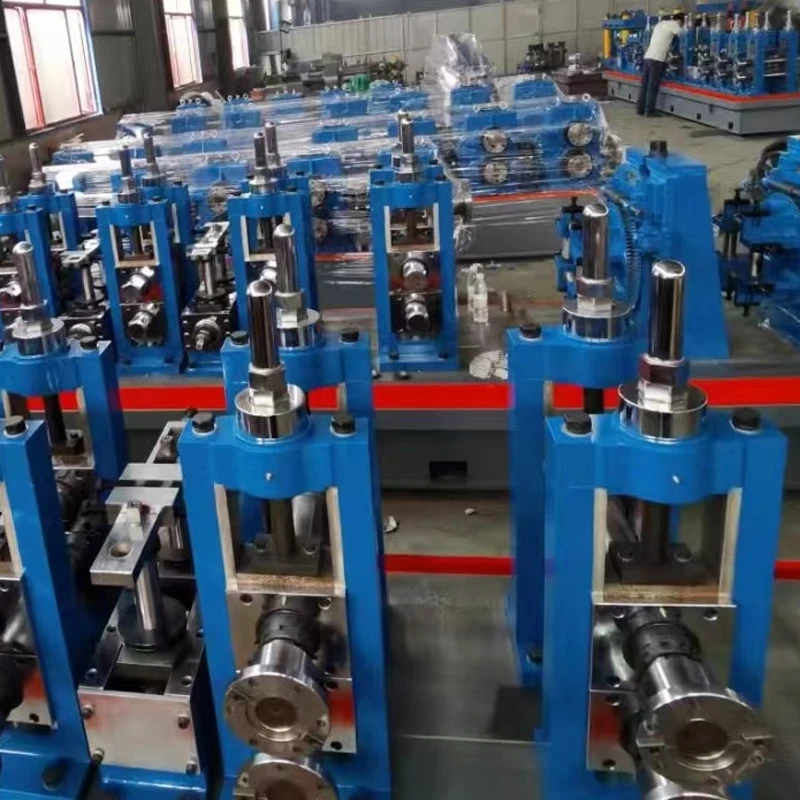cnc roll forming machine
Understanding CNC Roll Forming Machines A Comprehensive Overview
The evolution of manufacturing processes has brought forth innovations that enhance efficiency, precision, and versatility in production. Among these advancements, CNC (Computer Numerical Control) roll forming machines stand out as vital tools in metal fabrication and other industries. This article delves into the mechanics, applications, and advantages of CNC roll forming machines, highlighting why they are critical in today's manufacturing landscape.
What is CNC Roll Forming?
Roll forming is a continuous bending operation where a long strip of metal, or other material, is passed through a series of rollers to achieve a desired cross-section shape. The CNC roll forming machine automates this process through computer technology, allowing for precise control over various parameters such as speed, temperature, and shaping techniques. This automation enhances the repeatability of the production process, ensuring consistent quality in the final product.
Key Components of CNC Roll Forming Machines
A typical CNC roll forming machine comprises several key components
1. Feed Mechanism This allows the metal strip to be fed into the machines at a controlled rate. 2. Roller Set A series of rollers are arranged to gradually shape the metal into the desired form. Each roller incrementally bends the material, ultimately achieving the final geometry. 3. CNC Control System This is the brain of the operation. It manages the machine's movements, speeds, and other parameters, creating an automated and often touchless environment for operators. 4. Cut-off Mechanism Once the material is formed, this component cuts the product to the required length, ensuring precision in the finished pieces.
Advantages of CNC Roll Forming Machines
1. Precision and Consistency The computerized control of CNC machines ensures that each piece produced meets exact specifications. This precision minimizes waste and reduces the risk of errors.
cnc roll forming machine

2. Flexibility in Design CNC roll forming allows manufacturers to easily change designs using CAD software. This adaptability means that companies can quickly switch production lines to meet new demands or specifications.
3. Higher Production Rates With automation, CNC roll forming machines can produce metal shapes at high speeds. This increased efficiency translates into lower labor costs and higher throughput, making them economically advantageous.
4. Material Efficiency Roll forming can utilize thinner gauge materials compared to traditional fabrication methods, which helps reduce material costs while still achieving the desired strength and durability.
5. Complex Shapes and Profiles CNC roll forming technology enables the production of intricate shapes and profiles that might be challenging or impossible to achieve with other manufacturing techniques.
Applications of CNC Roll Forming Machines
CNC roll forming machines find applications across a wide range of industries, including
- Construction They are used to produce components such as door frames, steel studs, and roofing panels. - Automotive Roll-formed parts are commonly used for structural applications and trim components in vehicles. - Appliances Many household appliances rely on roll-formed parts for their structural frames and support mechanisms. - HVAC Ductwork and other air distribution components are often produced using CNC roll forming due to the need for precision and efficiency.
Conclusion
CNC roll forming machines represent a significant leap forward in metal fabrication technology. Their ability to combine precision, efficiency, and versatility makes them an indispensable tool in various industries. As manufacturing continues to evolve, the role of CNC roll forming machines is only expected to grow, allowing companies to meet the increasing demands for high-quality, customizable products while minimizing costs and waste. In a world where speed and adaptability are paramount, CNC roll forming machines are certainly paving the way for the future of production.
-
High Frequency Straight Seam Welded Pipe Production Line-BzZhou Xinghua Machinery Equipment Manufacturing Co., LTD.|Precision Welding, High EfficiencyNewsJul.30,2025
-
High Frequency Straight Seam Welded Pipe Production Line|BzZhou Xinghua|Precision Welding&EfficiencyNewsJul.30,2025
-
High Frequency Straight Seam Welded Pipe Production Line - BzZhou Xinghua|Precision Engineering&EfficiencyNewsJul.30,2025
-
High-Frequency Straight Seam Welded Pipe Production Line-BzZhou Xinghua Machinery Equipment Manufacturing Co., LTD.NewsJul.30,2025
-
High-Frequency Straight Seam Welded Pipe Production Line-BzZhou Xinghua Machinery Equipment Manufacturing Co., LTD.|Precision Manufacturing, High EfficiencyNewsJul.30,2025
-
High Frequency Straight Seam Welded Pipe Production Line-BzZhou Xinghua Machinery Equipment Manufacturing Co., LTD.|Precision Steel Pipe Manufacturing&Industrial EfficiencyNewsJul.29,2025


